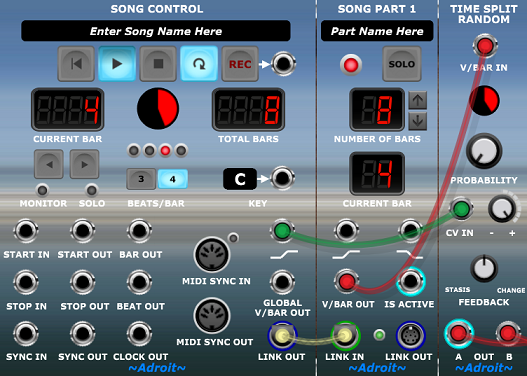
A Time Splitter module that can be used rather like Time Split 2 but instead of producing a regular pattern alternating between odd and even bars it enables you to create stochastic sequences.
In other words rather than a robotic ABABABABAB pattern this module can produce sequences like AABBABAAAB.
A high degree of control over the randomness factor is provided so this module should be useful for those interested in generative patches.
One very basic application might be to drive a pair of Rhythm Sequencers, each producing a different snare drum pattern…

The pie chart display element shows the current probability of the next bar being A (black) or B (red).
The PROBABILITY knob can be used to set the probability of B rather than A occurring to anything between 0% and 100%. The default (12 o’clock) setting gives an equal chance of either A or B becoming active in the next bar.

The CV IN socket and the attenuvertor on its right enable you to offset the PROBABILITY knob’s setting via voltage control. So for instance you could patch the Song Control’s POSITION CV output to this module’s CV IN socket to make the probability of A versus B gradually change over the duration of a song from being always A to always B with a mix of probabilities in between.

The FEEDBACK knob provides a means of automatically changing the probability of A or B being selected depending on which is currently playing. With the default (12 o’clock) setting, no feedback is applied.
Turning the FEEDBACK knob anti-clockwise increases the probability that the next bar will be the same as the current one. Turning the FEEDBACK knob clockwise increases the probability that the next bar will be different to the current one.
The choice between sequence A or sequence B being activated depends on the combined effect of the PROBABILITY knob, the CV IN voltage, the attenuvertor and the FEEDBACK knob. Complex interactions can arise but the pie chart updates in real-time to reflect the probability of the outcome so with a little experimentation it’s not too difficult to grasp what’s going on.
More Choice
This module makes a binary choice between A or B, but what if you want to randomly select between more than two sequences? The answer is to build tree like structures using multiple Time Split Random modules. The patch shown below plays four different patterns in a random order.

You aren’t limited to just powers of two choices as the “decision tree” does not need to be symmetrical. For example to randomly select between three sequences each with equal probability then one can use two Time Split Random modules…

To evenly distribute the probability then each sequence needs to have a probability of being chosen of 1/3. So the first time splitter’s probability is set to 66.6% and its B output is connected to another that has a probability setting of 50%. So we end up with roughly a 33.3% chance of each sequence playing.
You may have figured out that this technique can be further exploited as it produces “spare” V/Bar sequencing signals that can be used to drive other parts of a patch. So for instance in this last example the B output of the first time splitter produces a V/Bar signal that’s active when either the yellow or the blue sequencer is chosen. You effectively get extra sequencing options for free.
Once LSSP patches get beyond a certain scale you will find that there is often a useful V/Bar signal somewhere that can be put to good use. As well as saving modules this can sometimes provide creative inspiration and add to the cohesion of a composition.
Availability
The Time Split Random module is part of LSSP XL.